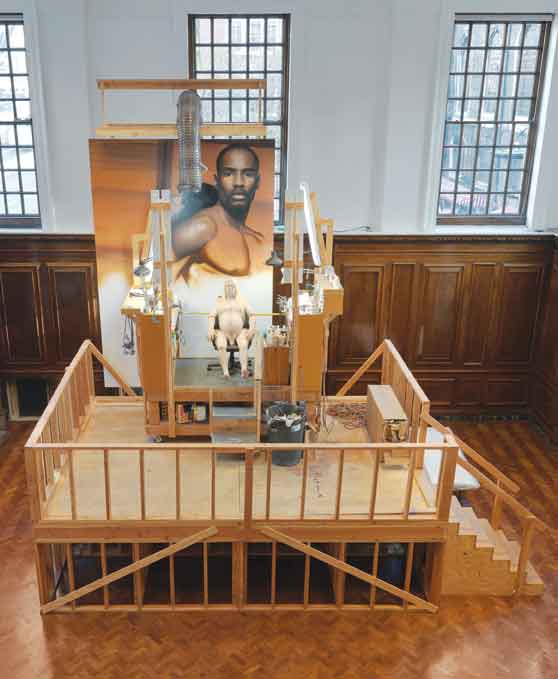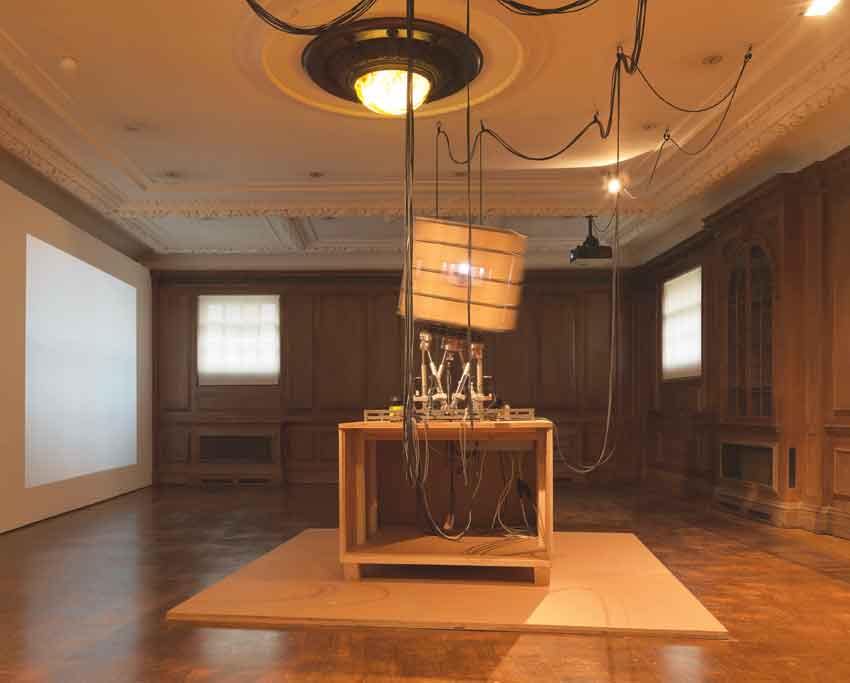« Features
Paul McCarthy: The King, The Island, The Train, The House, The Ship

Paul McCarthy, Train, Mechanical, 2003-2009, steel, platinum silicone, fiberglass, rope, electrical and mechanical components, 109” x 60” x 223”. Installation view, “Paul McCarthy. The King, The Island, The Train, The House, The Ship,” Hauser & Wirth London, Savile Row, 2011. © Paul McCarthy.
By Michele Robecchi
Paul McCarthy is contemporary art marmite. Love him or hate him, it’s impossible to deny his influence and relevance. Yet, even according to many of his supporters, “The King, The Island, The Train, The House, The Ship,” his recent solo exhibition at Hauser & Wirth and possibly one of the largest an artist ever held in a private gallery, started to reveal some cracks in the armor, with words such as “repetitious” or “predictable” ominously flying around during the opening night. Adrian Searle, The Guardian’s authoritative art pundit, questioned the validity of the show by suggesting that when even provocation goes unnoticed, as in this case, something is seriously wrong. Difficult as it is to believe, McCarthy has been fundamentally accused of mannerism. And once even an explosive combination of sex, food, popular culture and politics, like the one yielded by McCarthy in his long-standing career, comes across as ineffective if not altogether monotonous, where to go?

Paul McCarthy, Ship Adrift, Ship of Fools, 2010-2011, bronze, 203” x 144” x 288”. Installation view, “Paul McCarthy. The King, The Island, The Train, The House, The Ship,” St James's Square, London, 2011. © Paul McCarthy. All images are courtesy the artist and Hauser & Wirth. Photos: Alex Delfanne.
Truth to be told, exhibitions of this magnitude (the show spreads around two separate venues and comprises an outdoor sculpture in St. James Square) are always regarded with a hint of suspicion when organized by private galleries. It would be disingenuous though, to underestimate the strong working relationship that McCarthy and Hauser & Wirth have established over the years. It was McCarthy who had the honor to open the gallery’s London branch with Piccadilly Circus in 2003, a video work that successfully set a critical relationship with the history of the building where it was hosted. Two years later, on the occasion of the London leg of his traveling show “LaLa Land Parody Paradise,” McCarthy crossed the boundaries of the Whitechapel, installing part of the exhibition in the Copper Mill House just off Brick Lane, soon to become an off-site space for the gallery until its demolition. If viewed in this perspective, the mammoth effort behind “The King, The Island, The Train, The House, The Ship” quite makes sense. Although perfectly capable of working in much more reduced scales, McCarthy is at his best when given the opportunity to attack the housing architecture in its entirety. It is in these conditions that the complexity of his work can be fully stretched and appreciated, and it would be silly to have this aspect neglected when square meters, as in this case, are plentiful and available.

The King, (detail) 2006 – 2011, multimedia installation; acrylic on canvas stretched over board, wood stage, lighting, life cast, 4 pews. Overall footprint: 20' 3" x 40' x 27' 7”. Installation view, “Paul McCarthy. The King, The Island, The Train, The House, The Ship,” Hauser & Wirth London, Piccadilly, 2011. © Paul McCarthy.
But even technical considerations notwithstanding, the work McCarthy has put together over the past few years amply justifies this course of action. Pig Island (2003-2010), for example, arguably the centerpiece of the exhibition, is a massive installation that went through seven years of gestation before reaching its current form. It evolved in the artist’s studio through a process of accumulation, eventually blurring the boundaries that define an art work and the place in which it is situated, and represents one of these episodes in McCarthy’s art in which order and disorder brilliantly co-exist to form an apocalyptic picture. A huge variety of doll-reproduced characters, from George W. Bush to Angelina Jolie, along with randomly picked-up objects such as KFC paper cups, dusty music instruments, plastic chairs, buckets, bottles of wine and rusty bells, are sparsely displayed on the floor or on top of wooden shelves and polystyrene blocks. McCarthy has aptly defined Pig Island as a “sculpture machine,” and indeed like a living organism, Pig Island has been through different incarnations (a particularly convincing rendition was the one exhibited at Fondazione Nicola Trussardi last year), and has generated a series of parallel pieces, such as Train, Mechanical (2003-2009), a controversial double portrait of George W. Bush spookily rotating his head in circumspection while rhythmically sodomizing two pigs. This is apparently what hit a nerve. Nefarious as his influence has been in the past, the former U.S. president is now considered yesterday’s news.

Pig Island, (detail) 2003 – 2010, mixed materials, 420 ¼” x 360 ¼” x 204 1/8”. Installation view, “Paul McCarthy. The King, The Island, The Train, The House, The Ship,” Hauser & Wirth London, Savile Row, 2011. © Paul McCarthy.
His being a man from the old order, whose relevance in the current political situation is perceived as little more than nothing, is certainly a fact the skeptical part of the audience used to deem this recurring presence in the show as a sign that McCarthy’s work lacks urgency-a myopic gesture from an artist fossilized in revolutionary positions no longer sustainable. There is little doubt that if this was 2003, the year of Pig Island’s conception, Train, Mechanical would have had a very different kind of reception. Being that the endurance of a man’s active political life and his legacy are two very different things, there is clearly a lot to say about this view, and the mixed reaction that Train, Mechanical has caused seems to be a classic case of perception defined by the changing times rather than pure merits. Train, Mechanical is maybe outdated, but nevertheless it’s an impressive sculpture, and it goes to show how technological progress has served McCarthy well without diluting his corrosive outlook. The merzbau-esque nature of Pig Island and its contents might be disproportionate in relation to the time sensitivity of its content, but one doesn’t have to look too far to realize that McCarthy is still busy addressing the personal and collective demons that have informed his work for four decades with the same spirit and energy as when he started. Cut Up King (2011), for example, is a deceptive film featuring McCarthy and his assistants at work on one of his look-alike mannequins. The initial impression of witnessing what could amount to little more than a DVD extra is soon melted by the actions of the artist, who proceeds to sew and mutilate his naked doppelganger on a table as a mad surgeon in a sinister operating theatre. It’s a deeply disturbing experience and one that the presence of the very same figure sitting triumphantly in the middle of The King (2006-11), an installation positioned on the ground floor of the gallery in front of a group of church pews as if to emphasis its religious/fetishist status, does little to alleviate.

Mad House Jr., 2011, steel, plywood, electric cabinet, projection, 47 ¾” x 42” x 42”. Installation view, 'Paul McCarthy. The King, The Island, The Train, The House, The Ship', Hauser & Wirth London, Piccadilly, 2011. © Paul McCarthy.
As for the outdoor part of the exhibition, it’s important to remember that McCarthy has a rather complex story with the world of public sculpture. His monument to Santa Claus created on the occasion of the Rotterdam Festival of Sculpture in 2001 proved to be too much even for a architecturally dull place like that Dutch city, eventually finding a permanent location after years of debate in the central spot of Eendrachtsplein. In 2008, one of his inflatable sculptures in Bern unexpectedly collapsed, taking down a greenhouse and a power line in the process. Fortunately, Ship Adrift, Ship of Fools (2010-11), the monumental outdoor sculpture in St. James Square, is not too explicit or fragile. Casted in bronze, it looks like a psyched version of The Raft of the Medusa, with a visibly precarious ship and its improbable crew hurtling towards what appears to be certain destruction, merging surprisingly well with the “horse and steel”-inspired memorials that populate half of the parks in Central London. Loosely inspired by a medieval parable, Ship Adrift, Ship of Fools tells a story of power without restraint, knowledge without wisdom, age without maturity, and passion without love. It’s a sinister metaphor for the human condition, and one that brings us straight to the core of McCarthy’s credo.
Ever since the beginning of the world as we know it, in times of conflicts, a basic plot ancient as man himself has regularly emerged in the world of literature-the overcoming of the monster. The story of how the hero alone recognizes the danger the monster poses to the tribe, how he prepares for the confrontation, how he divines the monster’s secret and kills it, has been told for centuries in all civilizations as a harmless allegory for man’s struggle against evil. ‘Destroy All Monsters’, as two of McCarthy’s closest associates, Jim Shaw and the late Mike Kelley, had named their punk rock outfit in Detroit in the mid-1970s. McCarthy has individuated a real monster as well as the danger that lurks behind it, but he is not fighting it. There is no solution on offer, but a vivid representation of how dreams, when built over sentiments of denial and delusion, can quickly turn into nightmares.


































